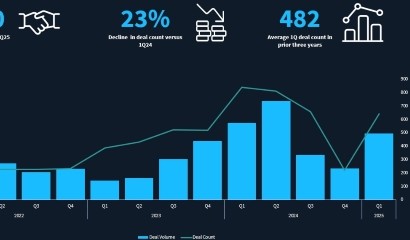Right on time: leveraged loan borrowers favouring shorter tenors pile maturities for 2028
The high interest-rate environment, combined with hopes that the hiking cycle is coming to an end, is driving companies to shorter tenors in the European leveraged loan market. The rolling quarterly average shows leveraged loan tenors have decreased over the past 12 months. While quarterly figures in 2021 and 2022 saw most loan tenors average between 6 and 6.5 years, these have dipped to 5.2 years in the 12 months ending in September.
This year’s standard tenor, now shorter than in previous years, is influencing the maturity wall and suggests a potential bottleneck in the future. Favouring the new five-year term means that deals issued in 2023 will fall due in 2028, further piling on to a significant amount launched in 2021. During that year, in the aftermath of the worst moments of the global pandemic, the leverage loan market boomed on the back of low interest rates. The reported record levels of issuance, with standard seven-year duration, will mostly be due in 2028.
Debtwire data show that 54.8% of the amount syndicated in the European leveraged loan market in 2021 (EUR 148bn) matures in 2028. In 2023, 55.2% of the volume issued up to October also falls due in 2028. The difference can be seen when looking at 2022 data, which shows issuers still opting for standard seven-year maturities, meaning most deals in that year mature in 2029.
Leveraged buyout loans left behind
The current trend for shorter tenors has been heavily influenced by demand for loans with proceeds used to refinance old debts, which have dominated the leveraged loan market in 2023, as refinancings reach their highest level for 10 years. In most cases, companies come to the syndicated loan space not for a strategic decision in their quest for growth, but because it is vital for them to extend their maturities. Naturally, those refinancing for necessity in a restrictive environment do not want to be locked into high rates for a long time, thus they favour shorter maturities, which, on average, they have managed to secure.
In the three months ending in October, average tenors in refinancing deals came in 1.2 years shorter in year-on-year (YoY) comparisons. The figure, currently at 5.27 years, has been below the five-year mark for a significant part of 2023, whereas it was above six years for half of 2022.
If, on the one hand, the primary rationale before setting maturity for a deal in most cases is a window of opportunity to refinance, on the other hand, leveraged buyouts follow an entirely different dynamic. A standard seven-year tenor speaks more about the cycle needed for a company to repay the debt, as cycles are hard to speed up. However, in a high-rate environment, the gap is squeezed between earnings and debt service, making it harder to repay and even precluding new buyouts, hence shorter tenors.
The cycle effect helps to explain why the issuance of loans to finance leveraged buyouts had collapsed 77% YoY as of end-3Q23, marking the worst year for leveraged buyouts in a decade.











